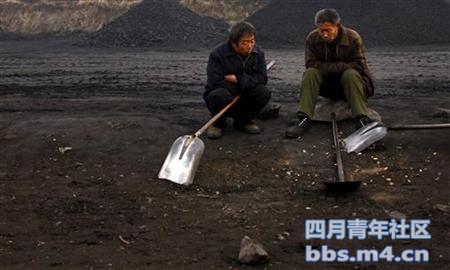|
|
Analysis: Coal's bridge to future might lie in the pasthttp://www.reuters.com/article/2011/12/11/us-coal-future-idUSTRE7BA0VK20111211

(Reuters) - As futuristic projects designed to capture carbon from coal-burning industries and store it underground have failed, the two largest consumers of the fuel, the United States and China, hope answers to limiting emissions blamed for global warming lie in the past.
Power-generators, coal miners and policy makers had put faith in projects to capture carbon dioxide from coal-fired plants and pump it directly underground into geologic formations for permanent storage. The great hope was that the technology would prevent much of the world's largest source of greenhouse gas emissions from reaching the atmosphere.
But so-called carbon capture and storage projects have collapsed like a row of dominoes this year in West Virginia, Scotland and Germany. The stumbling blocks have been high costs for the technology and bleak prospects the world will put a high price on emitting greenhouse gases.
Fortunately for those seeking to cut emissions from coal, one industry has profited for nearly four decades from socking away carbon dioxide emissions. That industry, enhanced oil recovery, is hungry for more of the gas.
Companies including Denbury Resources and Kinder Morgan have piped carbon dioxide from naturally occurring sources into aging oil fields to push out crude that traditional drilling is unable to reach.
As natural sources of carbon dioxide run dry, many of these companies are looking to industrial sources of the gas. Power utilities and other coal-burning companies may find it wiser to link up with this mature industry than to plunge ahead with their own versions of carbon capture and storage.
Originally, enhanced oil recovery specialists thought aging oil fields could store about 100 billion metric tons of carbon dioxide, or about 5 percent of what would be needed to reduce the threat of climate change.
But as researchers learn more about the storage potential of old oil zones, in both China and the United States, they say much more carbon could potentially be stored in these places.
"We've realized if EOR is going to be a bridge to steep carbon reductions ... that bridge is both wider and longer than originally realized," said Julio Friedmann, the technical program manager at the U.S.-China Clean Energy Research Center, formed in 2009 by U.S. President Barack Obama and China's President Hu Jintao.
Experts say success with enhanced oil recovery could give new life to the entire field of carbon capture by enlarging the market for man-made carbon, helping to build out a pipeline network to move it to market, and helping the business become more efficient in shooting the gas underground.
"Without commercial transactions, no one knows the price," said Deborah Seligsohn, an energy expert based in Beijing with the research group the World Resources Institute. She said enhanced oil recovery "would cause the price discovery and all the other commercial relationships that would need to get developed."
If the world does not widely deploy carbon capture and storage by the 2020s, the cost of limiting global temperatures would rise by $1.1 trillion, the International Energy Agency said last month in its annual outlook. This would put an "extraordinary burden" on other low-carbon technologies including wind and solar power, the IEA said.
Experts believe carbon dioxide used in enhanced oil recovery can be stored permanently underground because over time it is absorbed in brine and eventually mineralizes into a more stable form.
But there are risks, including pushing up water that contains heavy metals and other pollutants. Still, backers say the water can be re-injected underground.
An added benefit of enhanced oil recovery is the extra oil that could be produced in areas that have not traditionally been big petroleum centers such as Ohio, Indiana, and Illinois in the United States and Inner Mongolia in China.
As China scours the world in search of new oil supplies, one hope is that the country's old oilfields in the Bohai Gulf, which also happen to be near chemical plants that burn large amounts of coal, could see a second life.
China currently pumps its old oilfields with water, which is scarce, or polymers, which can be expensive.
After an initial investment in pipelines and other infrastructure, using carbon dioxide to push out China's oil could be a viable option.
So far, the United States leads China in enhanced oil recovery partly because small U.S. technology companies have been more nimble than China's big oil companies.
"It's smaller guys that do this cutting edge, creative stuff, and China doesn't have independent oil companies," said WRI's Seligsohn.
But China's Science and Technology Minister Wan Gang recently hosted an international conference on using emissions for coal plants, signaling the government is serious about moving into this industry.
And China boasts at least one advantage that even its huge state oil companies are finding hard to ignore: Its fleet of chemical plants that run on coal provide a far purer stream of carbon dioxide than coal-fired power plants do.
That type of discovery has made researchers more hopeful the United States and China can work together. "The more we've studied it, the better it works," said CERC's Friedmann. "The question is how to create a social legal regulatory framework to enable this technology."
|
|